By Susan A. MacManus, USF Distinguished University Professor Emerita
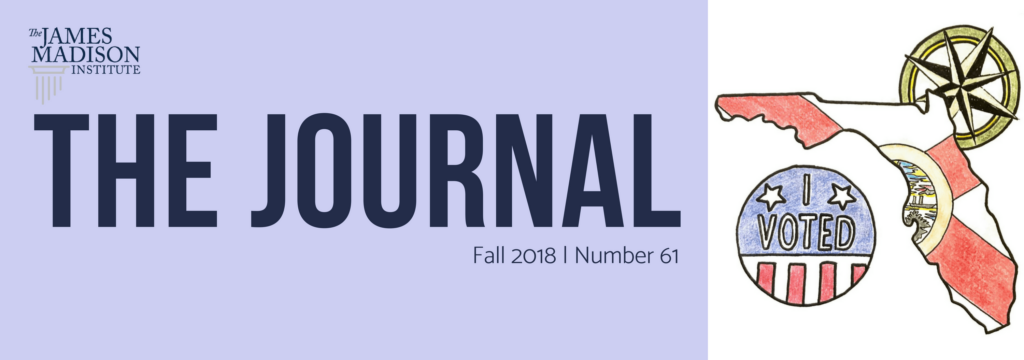
It is often said that Florida’s politics have largely been “imported.” There is some truth to that statement. Two-thirds of Floridians were not born in the Sunshine State. One in five was born in a foreign country.
Florida is now the nation’s third largest state. Its population growth in each decade since 1970 has been largely driven by the influx of people from other states and countries.[1] This pattern has significantly changed the demographic composition of Florida, making it one of the nation’s most racially/ethnically and age diverse. Over one-third (36 percent) of the state’s registered voters are nonwhite; 46 percent are under 50 years of age.
These two major demographic shifts have changed the state’s politics to the point where it is now:
- The most competitive in the nation. In the last four major statewide elections, the margin of victory for the winner has been one percent (2010 and 2014 gubernatorial, 2012 and 2016 presidential). The state’s role as a bellwether swing state in presidential elections has made its changing electorate of great interest to politicos and scholars alike.
- Nearly evenly divided between registered Democrats and Republicans (37 percent and 35 percent, respectively); the gap between the two major parties is the narrowest in the state’s history. Democrats have always outnumbered Republicans but now neither is a majority of the state’s 12.9 million active registered voters.
- A state where the sharpest increase in registration is with No Party Affiliation (NPA) or a minor party. The share of voters registering with the two major parties is shrinking. Who is most likely to view themselves as independents? The incidence is highest among Hispanics and Asians and the youngest generations.
- Fewer Floridians Registering as Democrats or Republicans
Fewer Floridians Registering as Democrats or Republicans
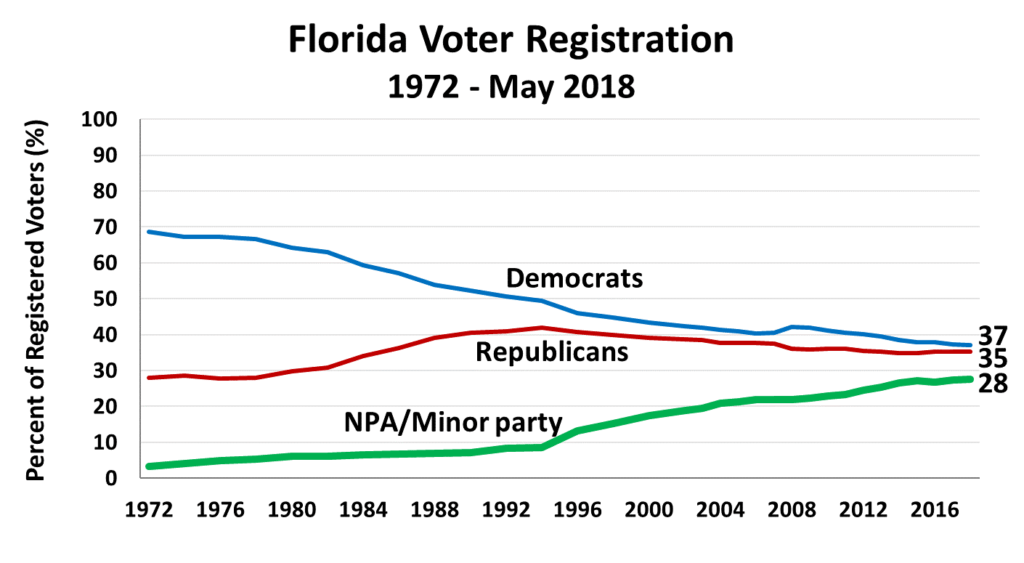
Florida’s Growing Racial/Ethnic Diversity
The influx of minorities from abroad and from other states over the past several decades has changed the state’s racial/ethnic makeup considerably. Hispanic and black Floridians make up a larger share of Florida’s populace (Asians slightly less) than of the nation at-large. But these broad labels mask country-of-origin-based cultural and political diversity. The group of Floridians who identify themselves as multi-racial is also on the upswing, challenging traditional race/ethnic-based micro-targeting strategies aimed at improving voter registration and turnout.
Hispanics (16 percent of Florida’s registered voters). Among Hispanic Floridians, the top countries of origin in order are: Cuba, Puerto Rico, Mexico, Colombia, Dominican Republic, Venezuela, Honduras, and Nicaragua. At one time, Cubans were the majority of all Hispanic registered voters and were mostly Republicans. That is no longer true. Non-Cuban Hispanics are now the majority. While it is true that Cubans are still the most Republican of all Hispanics, the younger generations are less so than their elders. Today, a majority of Hispanic voters are registered as Democrats or as NPAs.
Two-thirds of all migrants moving from Puerto Rico to Florida 2005-2016 moved to central Florida, where many Puerto Ricans already resided.[2] The same was true of the post-Hurricane Maria migrants. Of great interest in 2018 is whether the newly-arrived Puerto Ricans who have migrated to Florida after Hurricane Maria will register and vote Democratic or whether their real political impact will be felt more strongly in the 2020 presidential race when they will have had more time to put their lives back together. Historically, Puerto Ricans migrating straight from the island have tended to register as NPAs while those re-locating to Florida from other states like New York and New Jersey register as Democrats. In a one percent margin-of-victory state, both major parties are fighting hard for this new group of voters, fully aware that the future of their party is at stake.
Asians (2 percent of registered voters). The state’s Asian population, while small, has been growing at a rapid pace. From 2000 to 2010, they were the fastest growing racial group in Florida and the U.S.[3] They have moved to areas of the state with strong knowledge-based, STEM job growth[4]—near universities, high-tech industries, and military bases. Like Hispanics, Florida’s Asians are quite diverse, with the largest countries of identity being (in order): India, the Philippines, China, Vietnam, Korea, Pakistan, and Japan. As has been the case for many years, a higher percentage of Asians register as NPAs than as Democrats or Republicans. Historically, the Asian vote has been up for grabs[5] although, in recent years, they have leaned Democrat in their voting patterns.
Blacks (13 percent of registered voters). Florida’s black population, while not growing as rapidly as the Hispanic and Asian populations, has become more diverse as well, driven by the influx of foreign-born blacks from Haiti, Jamaica, Trinidad and Tobago, and the Dominican Republic.[6] Florida’s American-born black population largely registers as Democrats. There is slightly more partisan diversity among some foreign-born blacks. As with other races/ethnicities, a small but growing share of younger blacks are choosing to be NPAs.
Over One-Third of Florida’s Registered Voters are Nonwhite
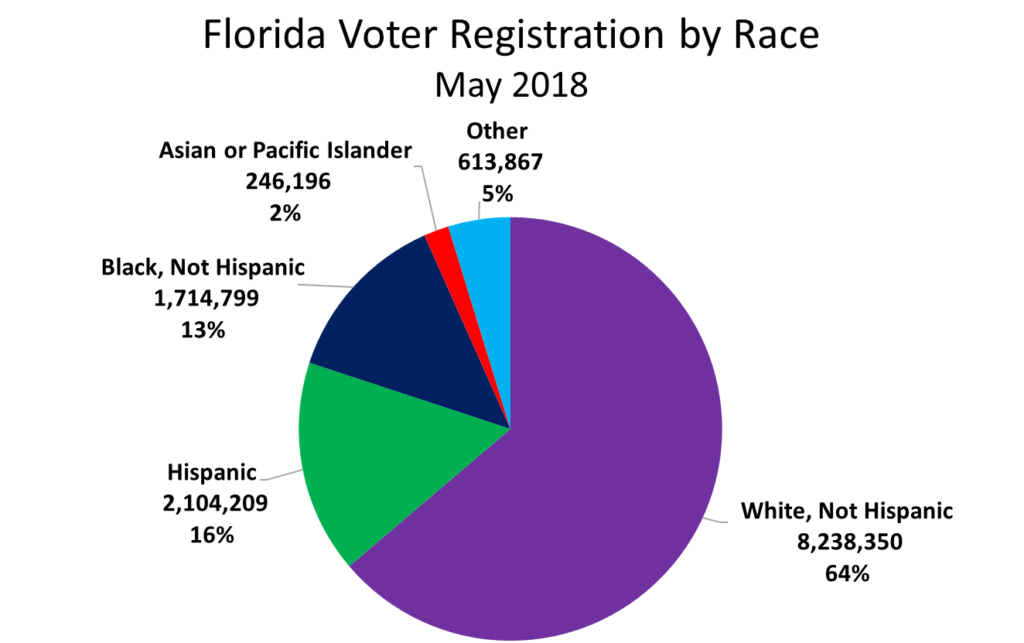
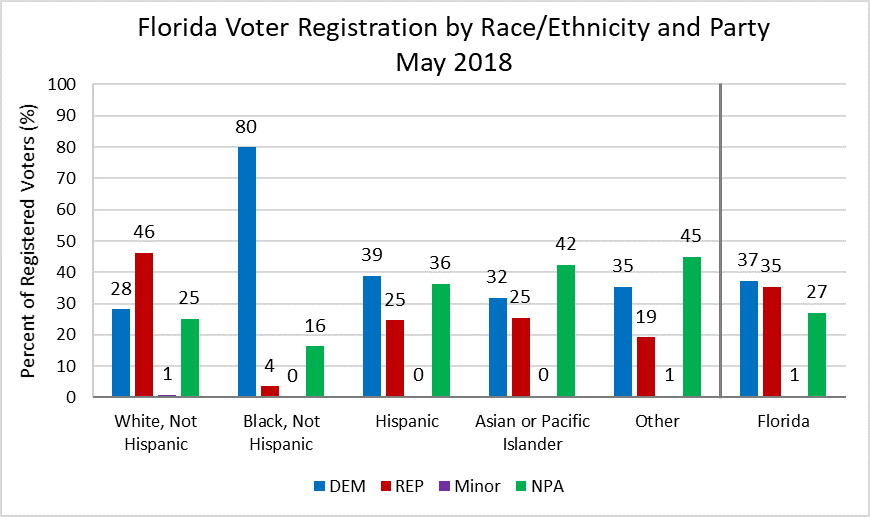
Young vs. Old: Age Makeup of Florida’s Registered Voters Changing
Florida’s continued reputation as a bellwether state in national politics is “the product of growing generational and ideological tensions between the state’s aging baby boomers and its more racially/ethnically diverse younger generations.”[7]
Nationally, in 2016, Millennials and Generation Xers combined cast more votes than Boomers and older voters.[8] The long-predicted “young vs. old” battle[9] is now front and center in Florida politics.
Many Floridians are unaware that younger voters are a growing share of the electorate. The truth is that Florida’s three youngest generations (#Generation,[10] Millennials, Generation X)—those ages 18-53 in 2018—now make up 52 percent of Florida’s registered voters, while the Baby Boomers, Silent Generation, and Greatest Generation comprise 48 percent.
One explanation for this trend is that racial/ethnic minorities, particularly blacks, Hispanics, and multi-racial individuals, are younger than whites. Another is that Florida’s reputation as a “job magnet” and fun place to live has attracted a lot of younger residents from other states.[11]
The biggest impact this “generational changing of the guard” has had on Florida politics is reflected in current party registration by generation figures. The younger the generation, the higher the share that is registering as No Party Affiliation. This pattern is very alarming to the two major parties, each of which is having difficulty figuring out how to effectively target this growing portion of the electorate, which can be the difference between winning and losing in a closely contested state like Florida.
Three Youngest Generations Make Up 52% of Florida’s Registered Voters
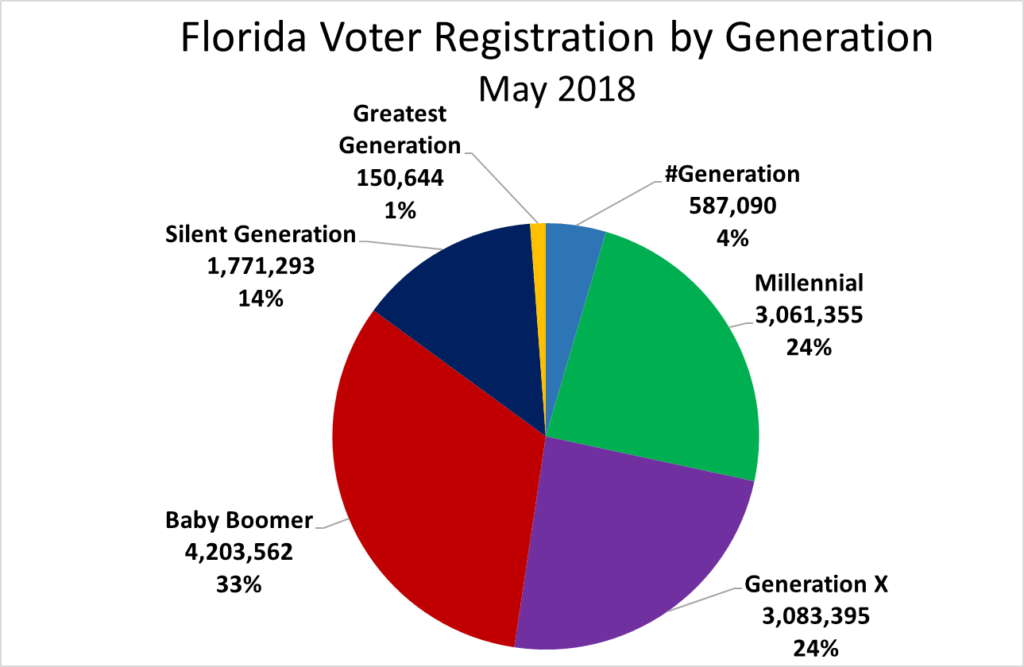
Generation X (38-53); Baby Boomer (54-72); Silent (73-90); Greatest (91+).
Source: Calculated by author from Florida Voter Registration System May 2018 data, Florida Division of Elections.
Fewer Younger Floridians are Registering as Democrats or Republicans
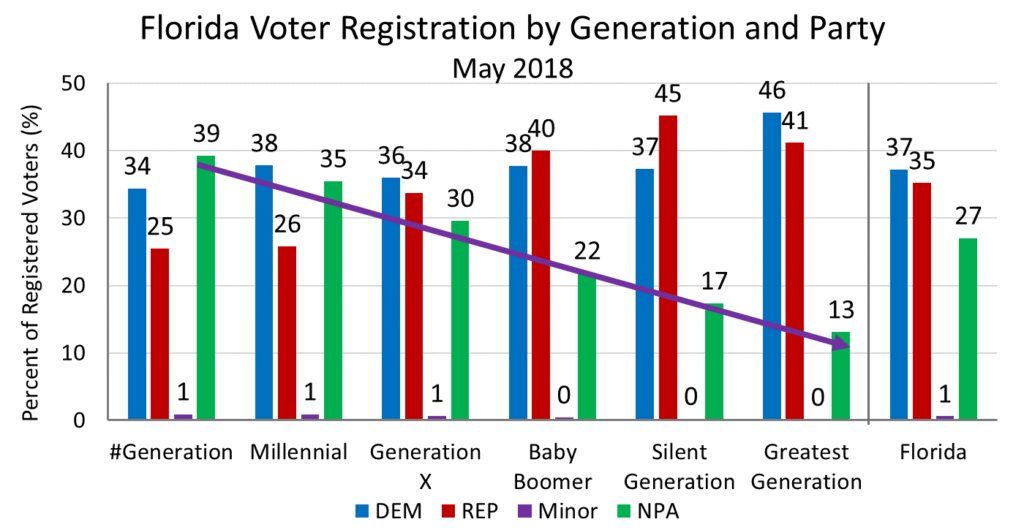
These NPAs cannot vote in a party primary yet we know that their turnout rate in a general election can be affected by a party’s nominee. That was evident in the 2016 presidential election when younger voter turnout greatly lagged that of older voters. The wider-than-usual turnout gap (56 percent among voters under 30; 82 percent among those 65 and older) was blamed, at least in part, on the dislike of both Hillary Clinton and Donald Trump by younger voters.
There are many questions about the likely participation rate of Florida’s younger voters in this year’s midterm election. To what degree will the shooting at Marjorie Stoneman Douglas High School, the #MeToo Movement, immigration, and criminal justice reform spark considerably higher-than-usual registration and turnout rates among the state’s younger voters? Will top-of-the-ticket races, especially the gubernatorial race, feature major party candidates that excite and energize these young cohorts? Or will they be driven to participate more by some of the proposed constitutional amendments like automatic restoration of felon voting rights or the one outlawing off shore drilling and vaping in public places? (Millennials are often referred to as the state’s strongest environmental issue voters.)
Predictions for a Widening Generational Gap
Projections are that Florida’s population will continue to diversify. Racial/ethnic minorities will become an even larger share of the state’s residents and the generational divide will deepen. According to new studies of U.S. Census data, racial minorities have been identified as “the primary demographic engine of the nation’s future growth, countering an aging, slow-growing and soon to be declining white population.”[12]
Demographic changes on the horizon will surely prompt political change. The big question in Florida is which major political party will benefit most? Democrats are hopeful this young “rising diverse electorate” will turn Florida blue again soon. Republicans believe that as taxes disproportionately negatively impact younger voters of all races/ethnicities, they will capture a larger share of the younger electorate—a longer-term view. In the meantime, among younger Floridians, the number registering as NPAs continues to increase…and it is anybody’s guess as to whether and how they will vote in the 2018 midterm election.
Read “Florida’s Changing Electorate: More Racially/Ethnically and Age Diverse” in JMI’s Fall 2018 Journal here: https://jamesmadison.org/wp-content/uploads/2018/09/Journal_Fall2018_FL_Electorate-1.pdf
[1] Ying Wang and Stefan Rayer, “Foreign In-Migration to Florida, 2005-2014,” Bureau of Economic and Business Research, University of Florida, April 15, 2016. https://www.bebr.ufl.edu/population/website-article/foreign-migration-florida-2005%E2%80%932014
[2] Ying Wang and Stefan Rayer, “Growth of the Puerto Rican Population in Florida And On The U.S. Mainland,” Bureau of Economic and Business Research, University of Florida, February 9, 2018. https://www.bebr.ufl.edu/population/website-article/growth-puerto-rican-population-florida-and-us-mainland
[3] Stefan Rayer, “Asians in Florida,” BEBR, September 21, 2017, https://www.bebr.ufl.edu/population/website-article/demographic-factors-driving-growth-asian-population-florida
[4] Professor Wei Li cited by Elaine Chen, “What The Lack of Asian-Americans Says About Miami,” WLRN-FM (NPR Miami), July 11, 2013.
[5] Tim Mak, “Asian-Americans Are the New Florida,” The Daily Beast, January 8, 2015.
[6] One in three black residents in Miami is now an immigrant. U.S. Census Bureau has projected that by 2060, over 16 percent of U.S. blacks will be immigrants. Franco Ordonez, “As Caribbean Immigration Rises, Miami’s Black Population Becomes More Foreign,” Miami Herald, April 10, 2015.
[7] Mary Ellen Klas, “Hispanic Growth in Florida: Will It Determine the [2016] Election?” Miami Herald, July 5, 2016.
[8] Amy Sherman, “Will Millennials Be The Largest Voting Bloc in 2018, as Rock the Vote Predicts,” PolitiFact, February 13, 2018.
[9] Susan A. MacManus, Young vs. Old: Generational Conflict in the 21st Century. Boulder, CO; Westview Press, 1996.
[10] The #Generation (18 to 21-year-olds) is referred to by the Pew Research Center as post-Millennials. In 2018, Pew Research ended the Millennial generation and designated its successor as post-Millennials. Michael Dimock, “Defining Generations: Where Millennials End and Post-Millennials Begin,” Pew Research Center, March 1, 2018. http://www.pewresearch.org/fact-tank/2018/03/01/defining-generations-where-millennials-end-and-post-millennials-begin/
[11] Casey Leins, “Young People Are Moving to These 10 States” [Florida ranked #4], US News & World Report, May 24, 2018; Livia Gershon, “Florida’s Best Cities for Young Adults,” CreditDonkey, 2018.
[12] William H. Frey, “The U.S. Will Become Minority White in 2045, Census Projects,” The Brookings Institution, https://www.brookings.edu/blog/the-avenue/2018/03/14/the-us-will-become-minority-white-in-2045-census-projects/











